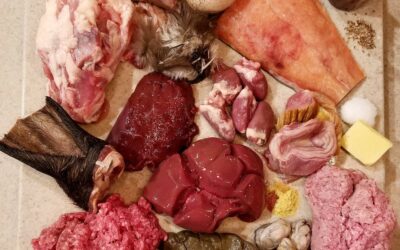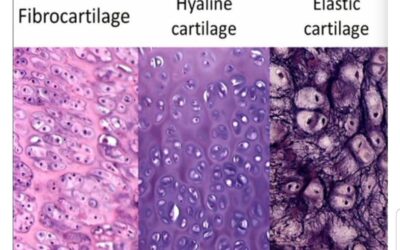Iron Supplements for Dogs: Facts & Dangers of Toxicity
PART 2 Should You Supplement?
The trace mineral iron often comes up low when pet parents are diligent to analyze their dog’s homemade raw meals. This can be perplexing especially since raw meals consist of the most iron-rich foods we can offer: organs, meat, fish, and bone marrow. Let me start off by saying, true iron deficiencies are extremely rare in dogs. Iron deficiencies occur as secondary conditions to a primary health condition such as kidney disease, gastrointestinal hemorrhage, hemangiosarcoma (tumor), autoimmune conditions, and other cancers. In the rare instance iron-deficiency anemia does occur, it is nearly always caused by chronic blood loss, most notably from gastrointestinal tumors. When it comes to puppies, iron deficiency can occur in pups infested with bloodsucking fleas, ticks, and hookworms. Because dam’s milk is low in iron, puppies are most vulnerable to anemia. Should a pet parent be concerned if an analyzed diet is coming up low in iron despite a meal replete with iron-rich foods? Is supplementation necessary? Let’s first take a look at some facts about iron and the dangers that surround it. Decades ago, Cambridge University’s Department of Medicine conducted a test entitled Iron Metabolism. The report written by Martin Hynes indicated the use of test dogs to determine iron absorption rates. Healthy dogs with normal blood iron levels (normal), dogs with high blood iron levels (plethoric), and dogs with iron-deficiency anemia were used in the study. The findings showed “a normal dog would absorb only very little of a test-dose [of iron] given by mouth, and a plethoric dog would absorb practically none, dogs suffering from chronic iron-deficiency anemia might utilize more than half of a small test-dose for hemoglobin production.” Why this is significant is the fact that iron, although an essential trace mineral, is also a very precarious metallic element that can be lethal. As a result, the bodies of humans and animals, as indicated in the test above, have a fail-safe that regulates and inhibits the absorption of iron in the presence of normal and high blood iron levels known as “free iron.” Even more, this test shows that even in the presence of anemia, iron absorption is not much better. Let’s consider this further. A dog’s body, like ours, regulates iron levels by adjusting the rate of iron absorption from the digestive tract. The iron-regulatory hormone known as hepcidin is released by the liver to maintain safe iron levels in your pet’s body. Hepcidin’s main function is to suppress the intestinal absorption of iron. If iron stores are high, hepcidin levels increase to reduce dietary iron absorption and prevent the release of stored bodily iron into the blood. If iron stores are low, hepcidin decreases resulting in a drop in bodily iron stores (this is resultant of iron being released into the blood) and an increase in dietary iron absorption in the intestines. In a healthy dog, there are only small amounts of “free iron” circulating in the blood. The “free iron” is bound to a protein (body minerals are organic being safely bound to a nutrient) which keeps the iron from doing harm to the cells. When dietary iron intake is coupled with iron supplementation, “free iron” levels increase. Because “free iron” is a pro-oxidant (the opposite of an antioxidant), oxidation occurs causing damage to cells. Excess iron is difficult for our pets to expel as dogs do not have a way to excrete or remove iron already stored in the body. Although a dog’s body will limit (and possibly prevent) the absorption of temporary high iron intake, continuous use of even low dose iron supplements will eventually lead to excessive iron levels. If “free iron” levels raise and remain consistent, the cellular damage can lead to death. To confirm my own studies, the article entitled Iron Toxicity in Dogs: Symptoms | Effects of Iron Poisoning in Pet Dog validates, “Iron toxicity is a form of metal poisoning in dogs. One’s pets are harmed more easily than the human owner by an iron overdose as these animals are not able to remove the excess iron easily from their bodies. Even if small doses of iron are given over a long time span, toxicity of iron can still develop in the body only because the body is not able to rid itself of the iron that is present already. Some of the main symptoms of iron poisoning in dogs is drowsiness, lethargy and listlessness and also vomiting. The dog may also suffer from bloody diarrhea.” Quite literally, iron, when in a surplus, is a fatally destructive poison. Corrosive damage occurs to the stomach and intestinal linings; the liver, nervous system, and cardiovascular system are severely impaired and injured; and damage to and alteration of cellular function and metabolic processes occur. In the article Excess Iron in the Blood in Dogs found on PetMD we learn, “In the event that there is a high volume of iron present in the blood, damage can occur within the cells. While iron is an essential nutrient for the regular functioning of a dog’s body, when it is present in large quantities in the bloodstream, it can become lethal.” For this reason, when it comes to the consideration of adding iron supplements, I am opposed. Unless you have your dog’s blood iron (ferritin) levels tested, or have a Hair Mineral Tissue Analysis completed (a service provided by The Holistic Canine), even the consideration of adding an iron supplement is cautioned against. The best approach is to take steps to ensure your dog is receiving adequate iron from meals as well as optimizing absorption. Increasing iron-rich foods is the safest way to ensure your dog receives adequate amounts of iron. Dogs require heme-iron which is found only in animal sources of food such as organs, meat, fish, blood, and bone marrow. Adding iron-rich vegetables will do little in the way of reaching iron requirements. If you are privy to a little secret, there is a nutrient that aids absorption of non-heme iron (plant sources of iron) that can give your dog’s diet a slight boost. Oddly enough, some of the highest plant-sources of iron contain oxalates and calcium both of which impair the absorption of iron in the gut. Dogs absorb anywhere from zero to minute amounts of iron from plant sources if it is not coupled with Vitamin C rich foods. Eggs contain an inhibitory phosphoprotein known as phosvitin that also binds iron. And feeding calcium-rich bone will also bind iron. Thankfully, Vitamin C has shown to reduce the inhibitory effect of egg proteins and calcium. One of the biggest hindrances to adequate iron absorption is phytic acid (phytates) found in grains and legumes, popular additions to commercial dog foods and some homemade meals. Seeds and nuts also contain phytic acid. Phytic acid binds with iron preventing its absorption. And guess what? Vitamin C saves the day again by increasing the absorption of iron in the presence of phytates. So bring on the Vitamin C! Incorporating fruits* and vegetables containing Vitamin C or a whole-food vitamin C supplement has proven to be an effective technique for boosting iron absorption when added to meals or even in between meals. Now if all of this is not problematic enough, if you are supplementing with zinc and/or copper, you are likely to cause an iron deficiency especially if you have fallen for the “more is better” motto. Another culprit is high fiber, also found in many commercial foods and homemade meals containing grains, legumes, and high amounts of seeds. Keeping all this in mind, now let’s consider why AAFCO and the NRC have a rather difficult-to-reach iron requirement. Iron requirements recommended by AAFCO and the NRC are reflective of the iron-binding issues of commercial dog foods. Raw feeding pet parents following AAFCO’s or the NRC’s recommendations may find their calculators or diet designer programs are suggesting their meals are hitting minimums for iron or are even coming up low. But as you have read above, as long as you are providing iron-rich organs, meats, fish, and bone marrow as well as Vitamin C rich vegetables and fruits* or a whole-food vitamin C supplement, you are providing adequate iron. Remember, your dog’s body will increase iron absorption by lowering hepcidin if iron levels are low. It is a delicate balance that is vital for preventing damage caused from high iron levels. Understand that iron is never absorbed anywhere near a rate of 100% where meals are provided regularly. This would be fatal. Iron is absorbed in the gut as an as-needed basis only. In the presence of lower dietary iron levels, absorption rate is highest. Alternately, the higher the iron intake the faster the absorption percentage falls. So in a nut shell, you CANNOT force iron absorption especially with iron supplements. In the event your dog has become anemic due to cancer, a ruptured hemangiosarcoma, kidney disease, gastrointestinal hemorrhage, or another condition, understand that iron supplements do not increase hemoglobin. A blood transfusion is necessary or intramuscular injections (that are very painful) given only by a veterinarian. You cannot remedy anemia with supplements. In fact, according to Trace Elements laboratory where I send hair samples for mineral analysis, “Taken alone over prolonged periods, iron supplements can result in anemia. This is due to iron’s antagonism to copper. Copper is necessary for the utilization of iron and if deficient can cause excess iron accumulation within the tissues, thereby not allowing iron to be incorporated into the hemoglobin molecule.” Thus, I would like to discuss iron supplementation further. All “natural” minerals are inorganic compounds found within the earth and sea. Humans and animals cannot utilize inorganic minerals and must obtain these vital nutrients from plants which convert inorganic minerals into organic nutrients that humans and animals require. Dogs obtain organic minerals by consuming herbivores and omnivores which eat the organic minerals contained in plants. The minerals within the organs, flesh, blood, and bones of prey are then absorbed by the canine’s body via the digestive processes and further utilized as needed. When both we and our animals are lacking in vital nutrients, we often unwittingly turn immediately to bottled sources. The problem with most mineral supplements is the fact that they are inorganic minerals chelated to another mineral or acid, thus remaining inorganic. On the supplement label, the mineral description and dosage will reflect to what the mineral is chelated. Most often the mineral name is followed by another mineral such as chloride (chlorine with a salt) and iodide (iodine with a salt) or an acid that will end in -ate such as ascorbate, carbonate, picolinate, and aspartate. These are not food, or what are known as organic minerals. These industrial chemicals are literally plant food. For a mineral supplement to be organic, it must be chelated to a nutrient such as an amino acid and/or a peptide. However, the safest and most bioavailable minerals are whole food sourced nutrients. Thankfully, whole food supplements can also come in a bottle! The most common iron supplements to blame for iron toxicity in dogs are ferrous fumarate, ferrous sulfate, ferrous carbonate, and ferrous phosphate (ferrous is a divalent iron compound). A lethal single-dose of iron is an excess of 20 mg/kg. I cannot stress enough to avoid these and other iron supplements. So let’s recap: The BEST and safest iron supplementation is to increase iron-rich organs, meat, fish, and bone marrow in the presence of Vitamin C. Period. As you have likely noted, nutrients work synergistically in a delicate balance of antagonism and partnership. The best way to avoid deficiencies and toxicities is to provide your dog’s essential nutrients through whole foods. ©2019 Kimberly Lloyd, PhD, BCHHP, Cert Raw Food Nutritionist *I do not recommend adding fruit to meals. Fruit contains natural sugars and digests differently from proteins and fats. If consumed along with meat, organs, and fats, fruit may ferment within the stomach and gut causing digestive upset, stomach discomfort, intestinal irritation as well as increasing the risk for bloat. I recommend feeding fruit as treats between meals.


